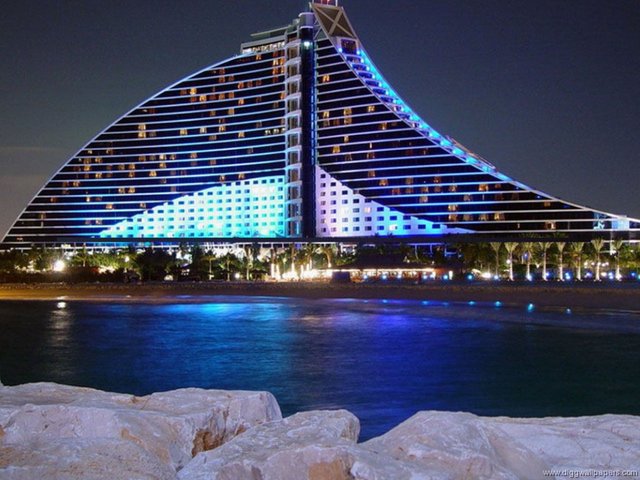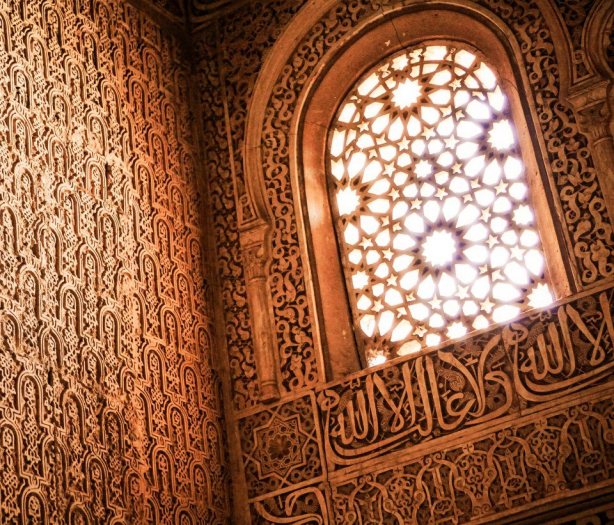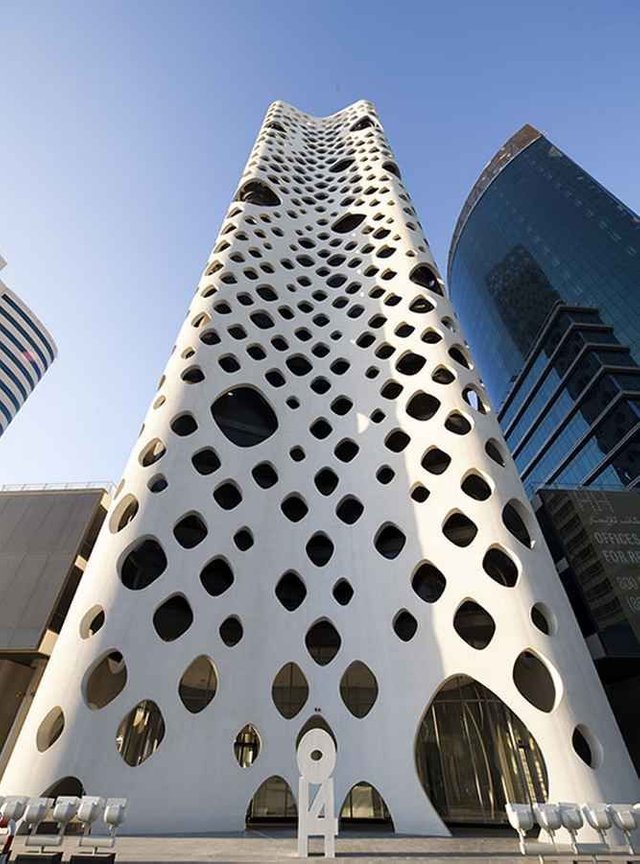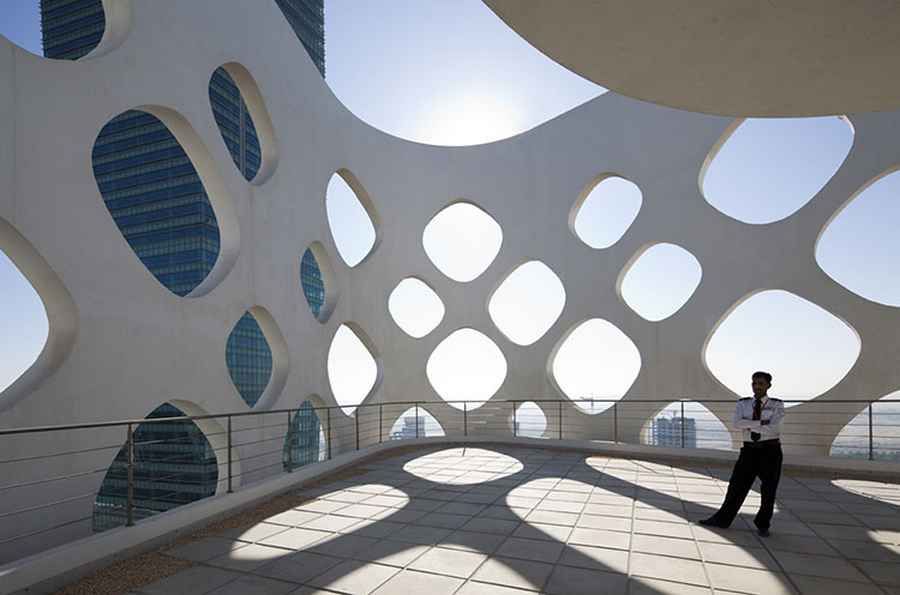Dubai is the manifestation of modernism’s Utopia, a world class city. Dubai is located in the midst of a desert and at a point, imagining the world class city that Dubai is today was far from possible. Dubai successfully caters to a high density population of its territory with the state of the art infrastructure that ensures a good lifestyle to its inhabitants. The infrastructure includes road and railway networks that ensure easy mobility in the city, skyscrapers that work as homes, shopping centers and other facilities. The government functions like a well-oiled machine that manages to address the emerging problems in a timely manner. Dubai is considered a tabula rasa, clean slate and the architecture is praised as an improvement to “nowhere land.” But is it?

source image
Dubai’s culture and Heritage:
People forget that Dubai has just as rich a culture and history as others. This nowhere land formed part of the Sassanid Empire that lasted into the 7th century, after which it became integrated into the Umayyad Caliphate and became introduced to Islam. Dubai has had strong ties to the heritage of Middle East but these ties are now becoming severed. Initially sustained by fishing and Pearl diving industry, Dubai lost its edge in the international trade with the introduction of artificial pearls in 1926 and the great depression in 1929 that caused the collapse of the international pearl market. In 1966, with the discovery of oil in the region, Dubai made a comeback into international trade and from then on the country has changed beyond recognition. Today, Dubai is a modern, vibrant tourist attraction and business hub. However, many have criticized Dubai’s transition into a more European sense of a city, as the attempt to gain a global identity is resulting in the loss of local culture and heritage and also, may even have long term harmful environmental effects to the land. But a revival of the old is underway.
Attempts to reimagine the heritage of Dubai or more specifically the Islamic art in the region are underway. One of these attempts is the skyscraper O-14 designed by Jessie Reiser inspired by the jaali, a feature found widely in Islamic architecture.
What is a Jaali?
The jaali is a perforated stone or a latticed screen, with ornamental pattern constructed in it through the use of either geometry, calligraphy, or both. It is found widely in the Islamic world and is a common feature in Islamic architecture. An example of this can be seen below:

source image
What is O-14?
O-14 is a commercial tower, twenty two story high, on top of a two story high podium, comprising 300,000 square feet and occupying a prominent space on the waterfront esplanade along the extension of the Dubai Creek. The design breaks away from the architectural norm of the city and is one of the unique buildings one can find in Dubai. The building does not have a curtain wall widely present in Dubai’s architecture, and it opts for a below ground parking. The building is surrounded by exterior shell of high-strength self-consolidating concrete known as the jaali. This exoskeleton provides shade, bears the concrete load and combined with below ground parking provides an open public space at the base of the tower.
As one can see, the jaali of O-14 does not resemble a traditional jaali but instead, consists of many holes of varying sizes. This is not surprising as the inception of the design to its execution is carried out by firms located in the west. However, while the resemblance to a traditional Jaali is lacking, by tapping into this design the building does adapt better to the peculiarities of the region, specifically its climate. The Jaali acts as a sunscreen that is open to air, light and views. The holes of the Jaali are designed depending on the requirement of the structure, luminosity, sun exposure and views. Furthermore, a gap of nearly 1 meter between the Jaali and the building itself create a ‘chimney effect’ whereby the hot air has space to rise which cools the surface of the building and the walls behind the Jaali and reduces the energy consumption by up to 30%.
What does this mean for Dubai?
The Jaali inspired O-14 may not be a return to the local heritage as one imagined but it is a step forward. The energy reduction feature alone signals to a shift from simply copying western architecture to adapting it creatively to the local land it is being implemented on. Dubai with its skyscrapers like Burj al-Khalifa and Burj ul-arab may dominate the media but O-14 is a work of art that one should not miss out on.


I lived in Dubai for two years, It is a very nice place but a bit expensive,
I like the old city especially the old boats that take you to the other side of the city.
but I really have some negative points about it but this is not the time to talk about that.
anyway what you mentioned is all right and EXISTS
Downvoting a post can decrease pending rewards and make it less visible. Common reasons:
Submit
Beautiful post and great photos! :)
Downvoting a post can decrease pending rewards and make it less visible. Common reasons:
Submit
The O-14 building doesn't look like it using a classic ornamental pattern concept. Actually, it looks more/less like a cheese. 😉
But I kind of like it... The architecture of O-14 looks very modern and suitable to 2020 era..
Downvoting a post can decrease pending rewards and make it less visible. Common reasons:
Submit
awesome
Downvoting a post can decrease pending rewards and make it less visible. Common reasons:
Submit
Wow!! I love the 0-14 building more. I hope to visit Dubai someday. Thanks for sharing @jasimg
Downvoting a post can decrease pending rewards and make it less visible. Common reasons:
Submit
This post has received gratitude of 12.54 % from @appreciator thanks to: @jasimg.
Downvoting a post can decrease pending rewards and make it less visible. Common reasons:
Submit
This post has received a 21.53 % upvote from @booster thanks to: @jasimg.
Downvoting a post can decrease pending rewards and make it less visible. Common reasons:
Submit
The magnificence of Dubai's buildings always astonishes me, but I hadn't really considered the cultural aspects of the architecture before and it's interesting to see how Dubai may be trying to integrate past patterns into modern bulidings
Downvoting a post can decrease pending rewards and make it less visible. Common reasons:
Submit
This post has received a 10.84 % upvote from @buildawhale thanks to: @jasimg. Send at least 1 SBD to @buildawhale with a post link in the memo field for a portion of the next vote.
To support our daily curation initiative, please vote on my owner, @themarkymark, as a Steem Witness
Downvoting a post can decrease pending rewards and make it less visible. Common reasons:
Submit
Great post, and really I love the modern spirit of this City.
Please have a look also to my post https://steemit.com/urban/@roberto.carrus/urban-design-cities-as-complex-systems
Downvoting a post can decrease pending rewards and make it less visible. Common reasons:
Submit